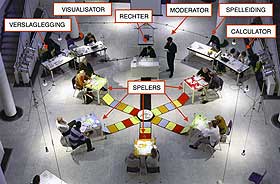The inventory provided knowledge about the constraints for future development and, above all, about the park’s existing qualities. That information was used as a guide for the concept development phase, which consisted of The making of game. Bureau Venhuizen reduced the information gathered to a manageable size and subdivided it into two categories: tasks (future developments: what must be done?) and phenomena (existing situations which do not necessarily have to be location-specific: what are the limiting constraints?). The seven tasks and phenomena were placed in a matrix and formed the basis for the game.

This meant that participants did not play in defence of their own ideas (which they could, after all, have expressed in the questionnaire or during a public consultation evening), but had to apply themselves to a proposed task linked to related phenomena. Thanks to the often unusual combination of task and phenomenon, they were forced to deviate from the most obvious patterns of thinking and most common solutions, thus creating more latitude for unusual solutions.
The debate among the participants themselves provided the complexity. This debate also ensured that public consultation did not simply target the municipal authorities, but meant that those involved personally experienced what interests other than self-interest are at stake. For example, one team had to make a plan that it did not actually support, but for which there was a demand. Or a team might have to raise objections to a plan to which it actually has no objections. Participants also discovered that what at first seemed like a wonderful plan was not feasible in practice or, conversely, what initially seemed impossible in fact turned out to be a sound proposal. Participants thus learnt how complex a design task is, but how it is still possible to apply themselves to it.
The game consisted of five rounds, with ten residents in each round, who worked together in two-headed teams on making proposals for the park. A winning proposal was chosen each evening, which was not necessarily the best one, but the one to which there was least resistance. In a final round, the decision was reached on who had drawn up the 'best' plan. The game generated a useful overview of the possibilities of a specific task and the limiting constraints, within which local residents assessed whether the realization of the plan was acceptable or indeed desirable.
The results of the game together with the inventory provided the input for the design brief for the designers. They presented the design proposals for assessment at two workshops with resident representatives. These local representatives were involved throughout the process in order to safeguard its progress and openness.
The design will be realized in phases starting in 2005.
